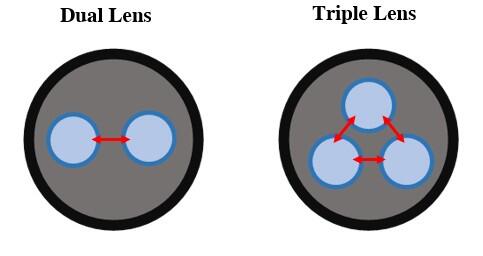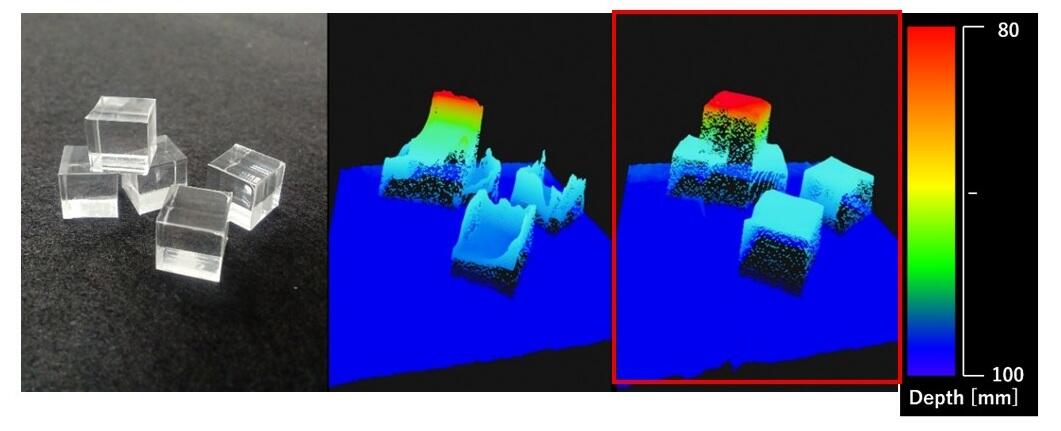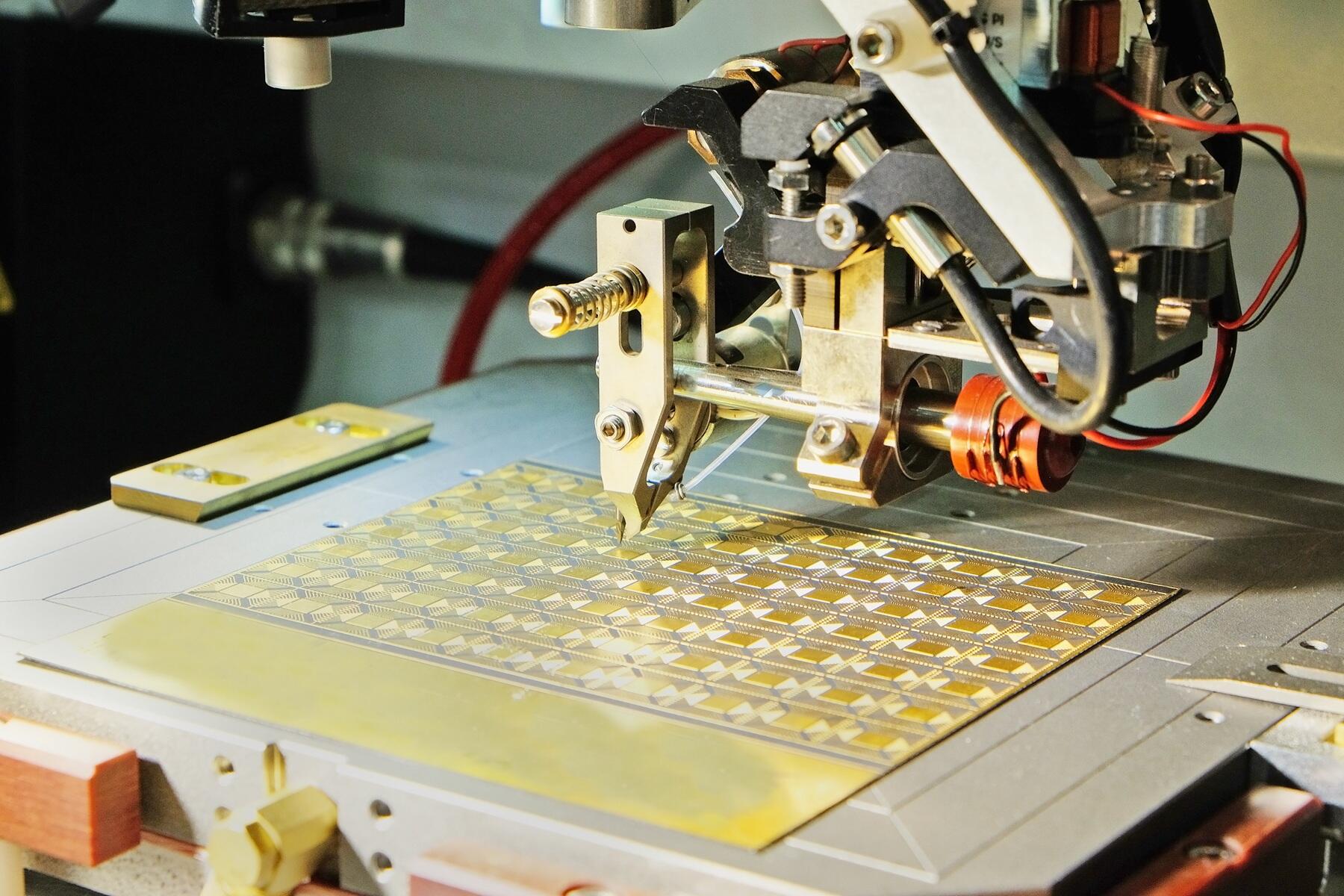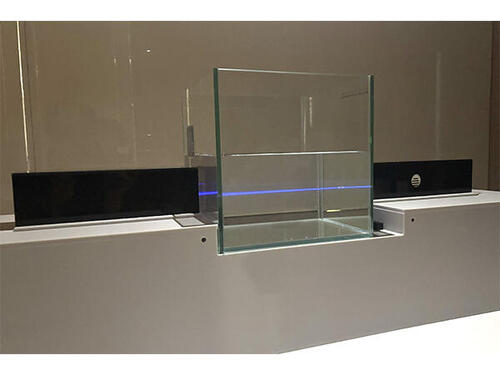Kyocera Corporation (President: Hideo Tanimoto; "Kyocera") has developed a Triple Lens AI-Based High-Resolution Depth Sensor for close imaging. The camera utilizes three lenses and proprietary AI to recognize semi-transparent, thin, and fine line-shaped objects that were previously difficult to detect with the human eye and traditional stereo cameras. The new Triple Lens AI-Based Depth Sensor accurately measures the distance to and size of such objects with more precision than ever before, tripling its precision measurement of tiny objects often difficult to detect with the human eye, from 1 mm to 0.3 mm. The triple lens is expected to help with inspection processes in manufacturing, improve precision in surgical robotics, and enable easier harvesting with agricultural robots.

Triple Lens AI-Based High-Resolution Depth Sensor
Size: 28mm x 30mm x 40mm (W x D x H)
■Main Features
The triple lens configuration enables precise measurements, including distance and size, of thin, linear objects positioned parallel to the direction between the left and right lenses. This capability allows the measurement of ultra-fine wires and different objects, such as:
- Thin, irregularly shaped linear objects, such as harnesses or ultra-fine wires
- Reflective objects like metal
- Translucent objects like plastic
■Development Background
Labor shortages can be a challenge in many countries, particularly developed nations, driving the need for further productivity improvements to compensate. As one solution, advanced vision sensing technology capable of object recognition as a substitute for the human eye is gaining attention.
In 2024, Kyocera developed a Dual Lens AI-Based High-Resolution Depth Sensor for Close Imaging capable of high-precision distance measurement with 100μm resolution at a 10cm range, allowing distance measurement of tiny objects around 1mm in size, even from reflective or semi-transparent objects, which was difficult for conventional stereo cameras.
However, distance measurement with a dual lens sensor can be challenging for objects with limited surface features or in environments where part of the object is obscured, preventing full recognition. Kyocera's new Triple Lens AI-Based Depth Sensor was created to solve these challenges.
■Features
Kyocera's new Triple Lens AI-Based Depth Sensor acquires three sets of parallax information--"left-center," "center-right," and "left-right"--from a close distance of 10 cm through the combination of three lenses and proprietary AI. Combining multiple parallax data sets virtually eliminates mismatches and reduces blind spots, significantly improving measurement reliability. It also enables accurate distance measurement for objects that were difficult to measure with a single lens, specifically those with repetitive patterns, partially reflective metals, translucent plastics, and other surfaces lacking distinct features. Kyocera's new AI-Based Depth Sensor can accurately measure distances to thin, irregularly shaped linear objects (e.g., harnesses) and ultra-fine wires with diameters as small as 0.3mm.

※Red arrow: Combination capable of acquiring parallax information
Figure 1: Schematic Diagram of the Dual Lens AI-Based Depth Sensor (Left)
and Triple Lens AI-Based Depth Sensor (Right)

Figure 2: Comparison of Measurement Results for "0.3 mm Ultra-Fine Cable"
Original image (left), Dual Lens AI ranging system (center),
Triple Lens AI ranging system (right)

Figure 3: Comparison of Measurement Results for "Overlapping Transparent Cubes"
Original image (left), Dual Lens (center), Triple Lens (right)
 Figure 4: Comparison of Measurement Results for the "Transparent TriangularPrism "Original image (left), Dual Lens (center), Triple Lens (right)
Figure 4: Comparison of Measurement Results for the "Transparent TriangularPrism "Original image (left), Dual Lens (center), Triple Lens (right)
■Future Developments
The improved accuracy of Kyocera's Triple Lens AI-Based Depth Sensor lends itself to a diverse range of industrial fields, such as:
1. Inspection Processes with High Repetition of Patterns
In inspection processes involving objects with highly repetitive patterns, such as electronic circuit boards or textiles, dual lens stereo cameras are prone to mismatching. The triple lens configuration, however, significantly increases measurement accuracy and reliability by utilizing multiple parallax combinations. This enables precise analysis of depth and surface shape, ensuring accurate measurements and minimizing mismatches.

2.Surgical Robots
Thin, highly reflective surgical tools, such as needles and sutures, are often hard to distinguish against their background and can be partially hidden from view. The triple lens configuration, three cameras at different angles, enables precise position recognition by combining information from multiple viewpoints, increasing accuracy and reliability in identifying these instruments.

3.Agricultural Robots
In crop harvesting and other complex environments where fruits and leaves occlude each other, the triple lens camera enables more accurate recognition and precise position measurement with minimal blind spots.

Kyocera will continue to develop technological innovations that create societal value and improve the lives of people around the world.
■Featured Technology at CES 2026
This technology will be exhibited at one of the world's largest trade shows, CES 2026, held in Las Vegas, Nevada, USA, January 6 -9, 2026 (local time). Kyocera's latest innovations in Underwater Wireless Optical Communication, Millimeter-Wave Sensors, Phased Array Antenna Modules, and other technologies to support safe, autonomous driving will be showcased at Kyocera's booth #6501, West Hall.
|
Date |
January 6 -9, 2026 |
|
Venue |
Las Vegas Convention Center |
|
Booth Location |
Vehicle Tech & Advanced Mobility Zone, West Hall. |
|
Booth Number |
#6501 |







